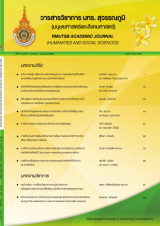การจัดการเรียนการสอนภาษาไทยในสาธารณรัฐกัมพูชา
Main Article Content
Abstract
บทความนี้เป็นการบันทึกความรู้ที่ได้รับจากการจัดการเรียนการสอนภาษาไทยในฐานะภาษาต่างประเทศแก่ชาวกัมพูชา ณ มหาวิทยาลัยบิลล์ไบรท์ เมืองเสียมเรียบ ประเทศกัมพูชา ด้วยกระบวนการสอบถาม สังเกต บันทึก ศึกษา และตีความ โดยมีวัตถุประสงค์ในการศึกษา 2 ประเด็นได้แก่ ลักษณะการเรียนรู้ และลักษณะการฝึกใช้ภาษาไทยของผู้เรียนชาวกัมพูชา จากการเรียนรู้ตามสภาพจริงด้วยกระบวนการพรรณนาวิเคราะห์ เพื่อนำองค์ความรู้ที่ได้รับมาเป็นฐานข้อมูลสำหรับแก้ปัญหาและพัฒนาผู้เรียนซึ่งพบว่า นักศึกษาชาวกัมพูชาส่วนใหญ่มีเป้าหมายการเรียนรู้อย่างชัดเจน มีต้นทุนด้านความอดทนต่อการเรียนรู้สูง และมีความตื่นตัวต่อการเรียนภาษาและวัฒนธรรมต่างประเทศ ทำให้สามารถเรียนรู้ภาษาได้อย่างรวดเร็ว
ส่วนลักษณะการฝึกใช้ภาษาไทยของผู้เรียนชาวกัมพูชาพบว่า มีปัญหาด้านการออกเสียง เนื่องจากหน่วยเสียงพยัญชนะต้นที่มีพื้นเสียงสูงหรือการมีเสียงวรรณยุกต์แบบไทยเป็นหน่วยเสียงที่ไม่ปรากฏในภาษาเขมร มีการสลับที่ของหน่วยเสียงบางหน่วยระหว่างภาษาไทยและภาษาเขมร หน่วยเสียงพยัญชนะท้ายบางหน่วยระหว่างสองภาษาไม่ตรงกัน หรือหน่วยเสียงพยัญชนะท้ายที่ตรงกันบางหน่วยในภาษาเขมรเป็นเสียงเลือน ตลอดจนการออกเสียงตามความเคยชินทางภาษา โดยเฉพาะกรณีคำร่วมเชื้อสาย ซึ่งสิ่งเหล่านี้ล้วนมีอิทธิพลต่อการออกเสียงและการรับรู้ภาษา แต่ในทางกลับกันก็ทำให้ผู้เรียนเกิดการถ่ายโอนทางภาษาแบบบวกด้วยความคล้ายคลึงด้านวงศัพท์และรูปประโยค แต่ทั้งนี้ผู้สอนจำเป็นต้องมีความรู้เรื่องไวยากรณ์เขมรและสามารถใช้ภาษาดังกล่าวสื่อสารได้บ้าง เพื่อใช้อธิบาย เปรียบเทียบหลักภาษาและพัฒนาแบบฝึกสมรรถนะทางภาษาอันเป็นประโยชน์สูงสุดที่ผู้เรียนพึงจะได้รับ
Thai language teaching in Cambodia
This article aims at collecting the knowledge which obtained from Thai language teaching and learning implementation for Cambodian learners at Build Bright University in Siem Reap, Camdobia. The data were achieved by utilizing interview, observation, taking note, studying and interpretation. The objectives of the study were 1) to study learning behaviors and 2) to study Thai language usage practice of Cambodian learners in the authentic circumstances via descriptive analysis. The gained knowledge from the study will be kept as the data base in order to solve the problem and improve the students. Having observed consistently, it was found that most Cambodian students had set their goals of learning obviously. In addition, the patience of learning led them to acquire the language and foreign culture rapidly and enthusiastically. Referring to Thai language usage practice of the Cambodian learners, it revealed that the learners had difficulty of pronunciation, since high initial consonant sound and the phoneme of tone mark level did not appear in Khmer sound units. Metathesis then was applied due to the difference of some final consonant sounds of both languages. Nonetheless, when the accordance of some final consonant sounds of both languages took place, it would be unclearly pronounced in Khmer language. What’s more, the familiarity of pronunciation, especially words family, and phonetic system relating to grammar rules of native language also influence pronunciation system and language awareness. Conversely, the similarity of these languages, i.e. sentence pattern and recognition vocabulary, would be beneficial for their learning. Nevertheless, the knowledge of grammar and the communication competency were needed for the teacher not only to explain and to compare both languages but also to contribute to create the language competency practice which would be the best thing that the learners should gain for learning success.


